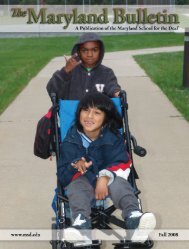Frederick Campus - Maryland School for the Deaf
Frederick Campus - Maryland School for the Deaf
Frederick Campus - Maryland School for the Deaf
You also want an ePaper? Increase the reach of your titles
YUMPU automatically turns print PDFs into web optimized ePapers that Google loves.
� Crisis intervention<br />
� Referrals to outside agencies<br />
� Consultation with a Child Psychiatrist (upon request)<br />
II. Counseling Services<br />
� Short and long term individual counseling<br />
� Consultation with parents, teachers and staff<br />
� Individual student planning<br />
� Curriculum-based classroom activities<br />
� Peer mediation groups<br />
III. Behavior Support<br />
� Behavior assessment and management<br />
� In-service training through staff-development activities<br />
� <strong>School</strong>-wide system of Positive Behavior Intervention Support (PBIS)<br />
IV. High <strong>School</strong> Guidance Services<br />
� Walk-in counseling <strong>for</strong> students seeking help related to academics and social interaction<br />
skills<br />
� Guidance instruction as outlined by <strong>the</strong> FCPS Guidance Curriculum<br />
� College and career advising<br />
� College admissions testing<br />
� Course planning and advising<br />
� ACT tests of Educational Development Administration<br />
V. Transition Services<br />
The MSD transition staff works with students and <strong>the</strong>ir families to plan and prepare <strong>for</strong> <strong>the</strong> student’s<br />
transition from school to life. Every MSD student, beginning at age 14, receives transition services. An<br />
MSD transition coordinator meets with each high school student every year to discuss <strong>the</strong> student’s<br />
plans, and to determine what services or activities are needed to assist <strong>the</strong> student in meeting his or<br />
her goals <strong>for</strong> <strong>the</strong> future. All MSD students receive transition services, beginning at <strong>the</strong> IEP meeting in<br />
which <strong>the</strong> child turns 14 years old.<br />
Transition planning includes…<br />
� helping students to identify <strong>the</strong>ir interest, preferences, and needs;<br />
� identifying each student’s possible post school goals (such as career direction, fur<strong>the</strong>r education<br />
or training, independent living, community access, leisure and recreational skills, needed support<br />
services);<br />
� developing with <strong>the</strong> student, a coordinated set of activities that will help <strong>the</strong> student reach <strong>the</strong>se<br />
goals;<br />
� preparing <strong>the</strong> student and parent to assume responsibility <strong>for</strong> accessing services and requesting<br />
needed accommodations in <strong>the</strong> community (self-advocacy);<br />
� linking students and parents with <strong>the</strong> employment/business community;<br />
� linking students and families with fur<strong>the</strong>r education and training options; and<br />
� linking students and families with adult service providers (DORS/VR, DDA, etc).<br />
These transition services, mandated by law, are defined as “a coordinated set of activities <strong>for</strong> a student<br />
designed within an outcome-oriented process which promotes movement from school to post-school<br />
activities.” After a student finishes school at MSD, <strong>the</strong>se activities may include: “post-secondary<br />
education, vocational training, community employment, supported employment, continuing and adult<br />
education, adult services, independent living, and community participation” (Public law 105-17, IDEA).<br />
Parent and Student Handbook, 2012-2013 <strong>Frederick</strong> 53






